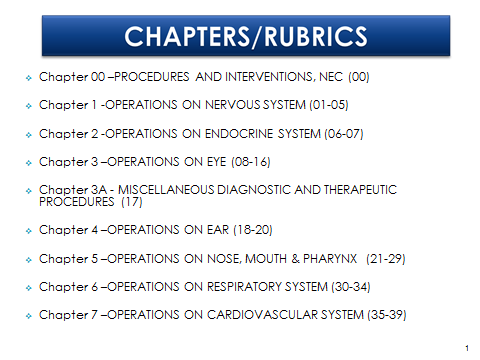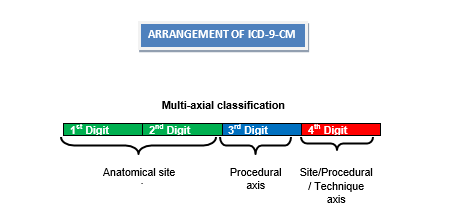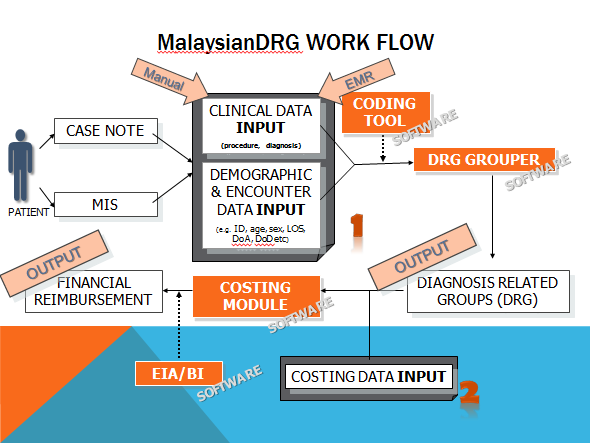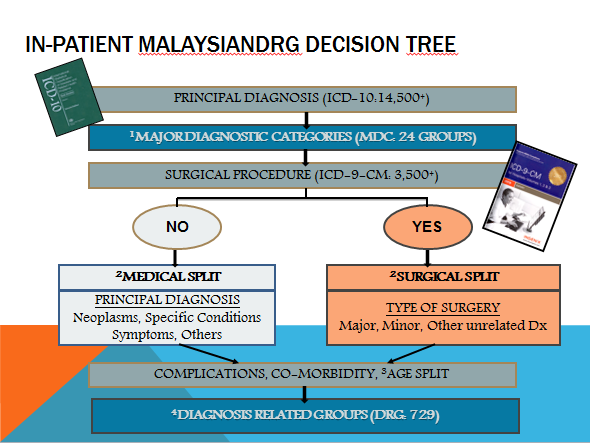ICD-9-CM Another Challenge And Responsibility to Medical Records Personal in Ministry Of Health Hospitals.
Introduction
‘The International Classification of Diseases, 9th Revision, Clinical Modification (ICD-9-CM)’ was originally based on the original version developed by the World Health Organization.
ICD-9-CM is structured into 3 volumes:
| Volume I (Tabular list of diseases) | Not practice in KKM Hospitals |
| Volume 2 (Alphabetical Index of diseases) |
Volume 1 and Volume 2 had been replaced by ‘The International Classification of Diseases and Related Health Problems, 10th Revision, Version 2010’.
Volume 3 ICD-9-CM version 2013 Procedure: (both alphabetic index and tabular list) is being used to code procedures.
1. Chapter : 00-16 ( 17 Chapters)
2. Rubrics : 00-99 (100 rubrics)
- Surgical procedures : 01-86
- Non-surgical procedures : 87-99
3. Structure of the classification is based on the anatomical site
4. Code : Numeric



Principal of ICD-9-CM and the roles of Medical Records Practitioner As A Coder
- To understand and to adhere the correct selection and assign the exact procedural codes.
- To assign codes upon all procedures documented in PER-PD 301 forms including attachments for every episode of treatment.
ICD-9-CM And Casemix System
The casemix system takes into consideration two (2) information to be entered in the MalaysiaDRG:
i. Demographic and Encounter Information.
ii. Clinical Information.
– Diagnosis: ICD-10 (multiple condition coding)
- Main Diagnosis
- Secondary Diagnosis
– Procedure: ICD-9-CM (Volume 3)
- Main Procedure
- Secondary Procedure

For every episode of treatment, main diagnosis and main procedure will be documented and codes will be assigned. Both codes will be key in into Diagnosis Related Group (DRG) grouper software. Hence, DRG will be generated.

Requirements For An Accurate Procedural Documentation Given To Patients For An Accurate Coding
- Medical Officer / Paramedics need to record all the procedures for every episode of treatment.
- Record accurately the main procedure which suites to the patient’s main diagnosis.
- Experience and understanding of the coders will have an effect upon the selection and accuracy of the codes selected.
Procedure to Assign Prosedural Codes by Coders
- Identify all procedures documented in the Hospital Admission and Discharge Form, Daftar Masuk Dan Keluar Hospital (PER-PD 301).
- Identify the lead term for each.
- Search in the procedures index.
- Refer to Tabular List including the “notes, inclusion and exclusion, omit codes and conventions in the relevant blocks (if any).
- Select the relevant codes based on the more specific codes to the 3rd and 4th digits (if any).
- Assign codes to all procedures.
Impact Of ICD-9-CM On The Casemix System
- Produce Diagnosis Related Group (DRG) including the cost incurred to treat the group of diseases in the DRG.
- To evaluate the performances of the hospitals/clinical departments using the analysis cost and monitoring the resources used.
- The disbursing of budgets and resources will be more accurate using the DRG compared to historical budget.
- The accuracy in selecting the ICD-10 and ICD-9-CM codes would determine the DRG for a certain group of diseases in the Malaysian DRG application. Thus,it would determine more accurately the financial budget to be received by a hospital base upon the output derived from the Casemix System.
The Challenges
1. Weakness in understanding:
- Classification of procedures – surgical and medical procedures.
- Anatomy & Physiology, Medical & Surgical Terminology.
- Non uniformity usage of abbreviations
2. The usage of ICD-9-CM books is new among the record officers.
3. The staff joining the medical records service are from multi disciplines.
4. Inadequate in experience and understanding among the medical records staff in selecting the accurate codes.
Remedies
1. Priority should be given to candidates those the science stream who could understand the anatomy & physiology, medical & surgical The requirements are essential as the the post is categorized as a member of the Allied Health and Science.
2. Continuous training and courses:
- Collaboration with the Nursing College for a certain period to attend courses in the subjects of Anatomy & Physiology, Medical & Surgical Terminology, introduction to procedures and types of procedures.
- Methods of reading, understanding and extracting information from the discharge summary or directly from the Patients Medical Records.
- Regular auditing of the procedural coding done.
- To have a single and uniform abbreviation in all KKM hospitals.
| Last Reviewed | : | 14 June 2017 |
| Writer | : | En. Anuar Bin Zainal |
| Translator | : | Tn. Hj. Lokhman Bin Dasuki |
| Accreditor | : | Pn. Oni Saifura Binti Osman |







